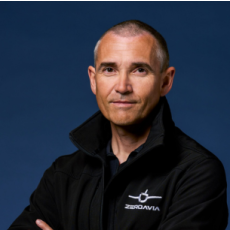ZeroAvia is a British/American hydrogen-electric aircraft company founded in 2017. It is developing fueling solutions for the world’s first zero-emission engines for the commercial aviation industry.
Many people within the industry challenge and resist the notion that aviation is a substantial polluting culprit, citing the fact that it only contributes to 2.5% of global emissions. What is your view on this relativity argument?
The figure of 2.5% for carbon emissions is correct, however, only a few years ago, it was sitting at 2%, now it's closer to 2.5%, and it continues to grow. Aviation is a fast-growing industry, especially in the cargo sector, which is now growing at about 10% per year, faster than the passenger side and moving to digital deliveries. Carbon emissions are just one aspect of aviation's climate impact; there are significant non-carbon effects. There are uncertainties about the exact size of these effects, but it's widely accepted they are substantial. Studies and experiments, like Airbus's plan to fly the A380 with a hydrogen engine to measure contrail formation, aim to reduce these uncertainties.
The consensus is that the total climate impact of aviation is about three times that of just carbon emissions, closer to 7.5%, making aviation a significant contributor to global emissions.
Your background is in the automotive industry, so what prompted you to launch ZeroAvia in 2017?
Before ZeroAvia, I founded my fourth company Electric Motor Works where we built smart charging networks for electric cars, aiming to balance the renewable grid with electric transportation. The idea was to use the battery capacity in electric vehicles to balance energy generation from renewables, like solar and wind, which are intermittent.
After selling this company, I wanted to do something in aviation, driven by my passion as a pilot and my background in avionics engineering from my father. I saw the need to address aviation's increasingly pressing sustainability issues and I saw an opportunity to catalyze a transition similar to what Tesla did in the automotive industry. Aviation revolves around engines, so new engine types can lead to new types of airplanes and services.
Outside of airports, who exactly do you see the most potential in terms of your target customers?
We primarily sell to operators, including airlines and cargo operators like British Airways, United, and American Airlines, who are also investors. They typically buy aircraft from manufacturers like Airbus and Boeing and engines from manufacturers like Rolls-Royce and GE. This market structure allows us to enter directly with these operators. To ensure smooth operations, we need ecosystem support, so we've invested in relationships with airports and infrastructure players like Shell and Mazda.
We see potential everywhere and are starting operations on the West Coast of the United States and in the UK, with launch operators in both regions. The UK has been particularly supportive, with strong relationships with the Aerospace Technology Institute and a mutual drive for innovation and supply chain development. The UK is also geographically dependent on aviation, making it more important to the government and people there, and sustainability remains a top agenda regardless of the political party, unlike in the US where it varies.
You recently announced a collaboration between ZeroAvia and Airbus in Canada in May. What can you tell us about this project?
This collaboration is exciting, very practical, and concrete. It's the first time all the top major airports in a country, like Canada, are signed up for this hydrogen transition. The collaboration covers all aspects, from fuel production and distribution to regulatory changes and infrastructure modifications. It goes deep into practical details like gate architecture and fuel delivery. We aim to have a blueprint for deploying hydrogen at these airports and set a standard for similar initiatives globally.
In terms of certification processes for these kinds of advanced technologies, are regulators sufficiently aware of both the potential and the associated risks?
The sentiment from Congress has been very supportive, recognizing the need for these advancements. What we're doing is not only great for the environment but also for business, connectivity, and health outcomes. This broad appeal has helped translate support into an actual mandate for the FAA as part of the FAA Reauthorization Act, which sets the direction for the next five years.
This act includes specific provisions for sustainable and hydrogen aviation, making the process more concrete. While there are still technical challenges and uncertainties, especially with larger aircraft, the regulatory direction is clear. Our focus now is on pushing through these uncertainties and getting regulatory approvals.
What are the current limitations to decarbonising a traditional fossil fuel industry with this hydro-electric technology?
We don't see a fundamental limit to the size of aircraft that can be converted over time. We paid a lot of attention to ensuring our technology would apply to all sizes of aircraft, not just a limited segment. Hydrogen is an excellent fuel with three times more energy per kilogram than kerosene, and fuel cell engines are more efficient than combustion engines. Hydrogen offers lower noise, no particulate emissions, and mitigates non-carbon climate effects.
Decarbonizing aviation is a complex problem. For initial launch targets of 10 to 20-seat aircraft, we're making good progress with prototypes and regulatory certifications. However, larger aircraft do pose more challenges. While the ecosystem and customer support are advanced, regulatory approval remains a primary focus. New certification bases and tests need to be developed for this new technology, which introduces uncertainties.





